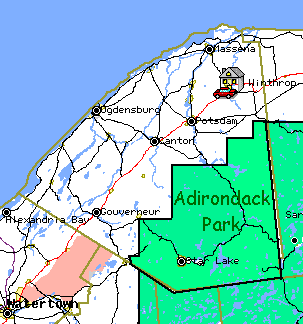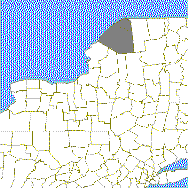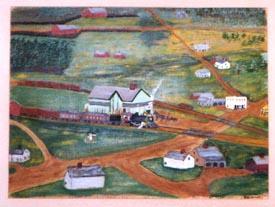 St. Lawrence
St. LawrenceCounty
 St. Lawrence
St. Lawrence
. . . . . . . .

.
.

"Winthrop 1898" painted by Seth Moulton
(see more paintings by Winthrop
folk artist, Seth
Moulton)
| The painting above is of my hometown, Winthrop, NY. It's located on
US Rt. 11 in the northern part of St. Lawrence County, which is said to be
the largest county east of the Mississippi. Whether it really is the largest
may be easily checked in an almanac, but I prefer to believe it is until
someone insists it isn't and I have to see for myself. Stretching about 75
miles across, the County comprises 1,728, 640 acres, or 2700 square
miles. "St. Lawence County is so big," declared Winthrop's late hermit,
Gordon Brown, "you could take the state of Rhode Island, stick it in
a corner of the county, and forget about it." Because of its great size, there is great variability in St.Lawrence County's geography. Beginning in the mountainous adirondack upland in the southeast, the land gently slopes downward toward the northeast through the rolling adirondack foothills, flattening out as it reaches the St. Lawrence valley and the St. Lawrence river. An old timer living in the St. Lawrence valley referring to his hunting camp in the Adirondack mountains would say he's headed "up south." This sloping aspect of the land greatly affects the county's climate, and hence, its growing season. Already short because of the region's northerly latitude, the adirondack upland growing season is further shortened by its high altitude, from about 140 frost-free days per year in Ogdensburg, to only 110 in Wanakena. Gardeners and landscapers have to be careful selecting their plant stock. A tree grown in Tennessee, even though the species is native to upstate New York, would be lucky to survive a single winter in St. Lawrence County. The soils are diverse as well. The rich, silty, floodborne loams in the valley gradually give way to sandy, drouthy, unproductive soils of the upland. Superlatives are thematic in St. Lawrence County. In 1993, Winthrop was home of the world's largest pumpkin, tipping the scales at 884 pounds. But another less celebratory superlative applies to St. Lawrence County—it's the county with one of the highest unemployment rates in the state. Mines petering out, farms liquidating, factories shutting down, and railroads pulling up their tracks have in only a few short years plunged the area into a state of a near-depression. Retirees, hold-out farmers, and a shrinking number of factory workers remain to sustain the area's struggling economy. Recently, however, the crumbling mainstays of the north country economy have given way to a promising new industry which has breathed new life into the north country's economy—prisons. Some may raise eyebrows at the notion of dotting the North Country landscape with "correctional facilities," as they are euphemistically called, but as a prison guard friend says, "it beats the hell out of running a chainsaw in the woods ten hours a day." While they have image problems, they affect the environment less than say, a pulp mill, or an aluminum plant, and they've helped stem the exodus of the region's most precious resource: its youth. What lies ahead for St. Lawrence County is speculative, but a stagnant economy doesn't mean the area is immune to change. About forty percent of the county lies within the Adirondack Park. With the park's strict land use policies it is unlikely that the land will change much. The future of the other sixty percent, however, is less certain. Politics will likely play a strong role. There is a constant tug-of-war going on between those who advocate growth, and those who want to preserve the land. As long as the economy is in the doldrums, the growth advocates will have more clout. When I was an over-the-road trucker, I noticed how growth occurred in other parts of the country, and I questioned whether I wanted to see St. Lawrence County grow the same way. Around cities I saw vast shopping complexes, strip malls, dollar discount marts, junk-food joints, particle-board garden apartments and sprawling tract homes gobbling away at the surrounding countryside. Suburban sprawl is often ugly, disconnected, environmentally unsound, and, as someone once said of Oakland, California, "there is no there there." City and regional planners are only now beginning to assess the impact suburban sprawl is having on the rural landscape. Three million acres a year in farmland alone is lost to development in this country, one million acres of which is prime farmland. But most of the farmland in St. Lawrence County was abandoned because its soils were always poor. Many farmers were paid by the government to liquidate. Farmers who own prime bottomland in the St. Lawrence valley are not under pressure to subdivide their land, since there are no expanding cities to drive up the price of land. But the character of the rural and small town landscape is changing in St. Lawrence County, only more slowly and in different ways than around major metropolitan areas. We don't see towering office complexes and megamalls here, but—as we see in small towns across the country—strip malls, fast food joints, dollar stores, and convenience stores spring up everywhere, siphoning dollars away from the traditional town center businesses. Sorry, in progress. . . . |